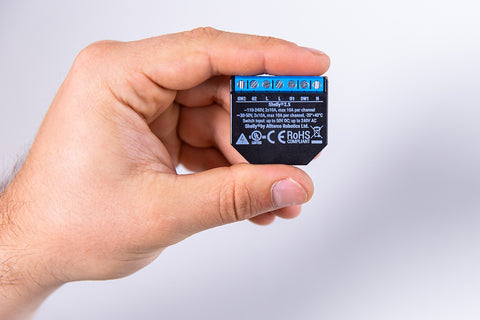Smart home automation is becoming increasingly accessible, and among the popular solutions are smart relays like the Shelly 1 and Shelly 2.5.
These devices offer the ability to control various aspects of your home remotely, including lighting and appliances, and can be an integral part of a DIY smart home setup.
The key is choosing the right one for your needs. That's why we've put together this comprehensive comparison of the Shelly 1 and Shelly 2.5 to help guide your decision.
Shelly 1
Shelly 1 is a compact WiFi-operated single relay switch that you can use to control a wide range of appliances and light sources. It can handle up to a 16A load and has an integrated temperature sensor.
The device supports weekly scheduling and sunrise/sunset timers, allowing for the automated control of your devices. Shelly 1 can operate in conjunction with the Shelly Cloud app, MQTT, or REST API, making it a versatile option for many smart home systems.
Shelly 2.5

On the other hand, Shelly 2.5 is a double relay switch and roller shutter packed with features. It can control two circuits or one motor, and is developed for a maximum load of 2x2300W or 2x10A.
Shelly 2.5 also has integrated temperature sensing and supports the same scheduling and timer features as the Shelly 1.
This device can be controlled via WiFi through the Shelly Cloud app, MQTT, or REST API, and also supports power monitoring, providing insights into your energy usage.
What's the difference between Shelly 1 and Shelly 2.5?
While Shelly 1 and 2.5 share many similarities, they also have key differences. Shelly 1 is a single relay switch that can control a single circuit, whereas Shelly 2.5 is a double relay switch that can control two circuits or act as a roller shutter controller.
Shelly 1 can handle higher individual loads (up to 16A), while Shelly 2.5, despite having two circuits, can only handle a combined load of up to 10A. Furthermore, Shelly 2.5 offers power monitoring, a feature not available in Shelly 1.
Pros & Cons
Shelly 1
Pros
- Can handle up to 16A load.
- Supports various control methods (app, MQTT, REST API).
- Has an integrated temperature sensor.
Cons
- Controls only a single circuit.
- Does not support power monitoring.
Shelly 2.5
Pros
- Can control two circuits or a motor.
- Supports power monitoring.
- Has an integrated temperature sensor.
Cons
- Maximum combined load is 10A (though it's dual channel).
- Might be overkill for simple single circuit control.
Full Spec Comparison Table
| Shelly 1 | Shelly 2.5 | |
|---|---|---|
| Relay type | Single | Double |
| Load capacity | Up to 16A | Up to 2 x 10A |
| Temperature sensor | Yes | Yes |
| Control methods | Shelly Cloud app, MQTT, REST API | Shelly Cloud app, MQTT, REST API |
| Power monitoring | No | Yes |
| Roller shutter control | No | Yes |
| Scheduling & timers | Yes | Yes |
Conclusion
The decision between Shelly 1 and Shelly 2.5 depends on your specific needs. If you need to control a single high-load device, Shelly 1 would be fine.
However, if you require control over two circuits, a motor, or wish to monitor your power usage, Shelly 2.5 would be the better option.
The Shelly 2.5 is the newer, more competent device and you an purchase it here.









